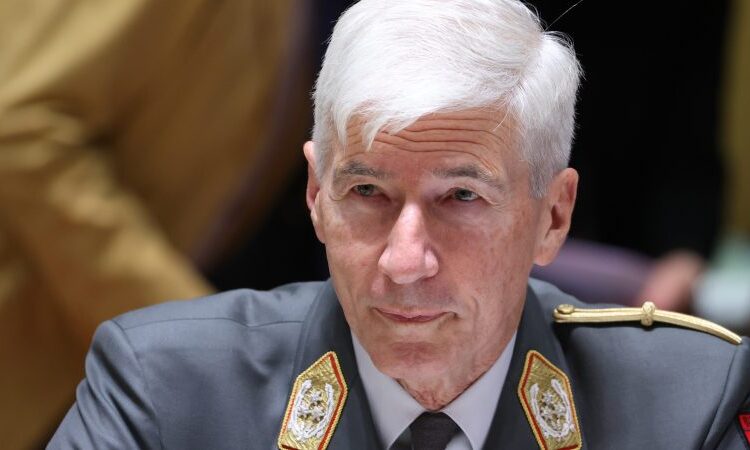EU looks to convince countries to invest in crisis management force, top military chief says – Euractiv

The EU should use its common budget as an incentive to make member states commit more capabilities and personnel to the bloc’s future crisis response force, the EU’s top general, Robert Brieger, told Euractiv.
“There’s unfortunately a big array of crises [around Europe], the situation is worsening rather than becoming better and we have to have a tool for rapid deployment of such an entry force,” the Austrian general said in an interview.
The bloc’s future 5,000-strong Rapid Deployment Capacity (RDC) “is a modular and scalable tool – a small one – that can be used as an entrance force, a first responder, for more to come afterwards, for crises management mainly, outside the EU.”
The RDC was established by the EU’s Strategic Compass, the bloc’s first military strategy, and is meant to be operational by 2025 and used as the first responder force in a crisis outside the EU, for evacuation, delivery of humanitarian aid, capacity building or peace enforcement.
Until then, more work is needed for it to become operational. During the first force generation conference, “a lot of offers were taken into account, but there are still some gaps, especially in the first semester of 2025,” Brieger said, adding that “we try to fill them within the months to come”.
Brieger, chairman of the European Union Military Committee (EUMC), the highest military body in the EU, advises the EU’s chief diplomat, Josep Borrell, on military matters.
EU member states pledged to the bloc’s future joint force after a first operational exercise on the coast of Spain in October with the participation of nineteen out of 27 EU countries.
“For this endeavour, we for sure need incentives – besides the political will – for member states to buy in this new system,” Brieger also said, hinting that turning political commitments into actual commitments would be a challenge.
Asked what gaps were identified, Brieger answered they concerned “especially the first semester of 2025, when there’s one battlegroup missing [in the roster]”.
More generally, EU countries need to step up the amount of equipment they could earmark for the RDC, he said.
“We have gaps for strategic enablers; for instance, joint logistics or strategic transport,” he said in reference to the lack of a long-term solution to complement the arrangement with the European Air Transport Command (EATC) in case of short notice needs for transportation.
Another gap to fill to make the RDC really operational relates to work on military mobility across the continent – to facilitate the ease of movement of troops and equipment with infrastructure, procedures and less red tape.
Incentivising contributions with EU money
To push EU member states to commit more troops and equipment, the EU’s military committee is “thinking about some sort of covering common costs: part of the expenditure will be covered by European financial resources”.
“The discussion is ongoing now on how far can we use the European Peace Facility (EPF) or administrative budget,” he said.
The EPF is an inter-governmental fund used to provide defence equipment to third states, pay for the EU’s military missions and operations, and the RDC’s exercises.
“We are discussing financial support or a certain amount of common cost for EU exercises, for the missions and operations and also for the use of the RDC,” the general said, adding that the idea would need endorsement from the politicians.
While the principle that the costs lie where they fall is the “priority. (…) We need the incentive to at least cover some costs, like for instance strategic transport, logistics costs, housing etc, so that member states are more willing to participate than in the past”.
Complementary to NATO?
The current format of the European force – the EU battlegroups – has never been used in the field.
Compared to a battlegroup, the RDC is larger in size, involves an EU overview of personnel and equipment available in the roster, combines air force, maritime, cyber, land and space assets, and is based on clear scenarios in which it could be used.
“We didn’t use the battlegroups because there was no political will, there was no sufficient budget”, while “there have been in the past opportunities and necessities to use them and I think opportunities are sure to come also in the future”, such as the evacuation from Sudan after the coup d’état.
Eastern member states such as Estonia, Latvia, Lithuania, and Poland have expressed numerous times the wish to preserve the US-led Western military alliance NATO’s force model and avoid jeopardising its reaction abilities with the EU.
One of the main arguments raised against the RDC is that an EU member which is also a NATO-allied country cannot assign the same personnel and equipment to both organisations’ force models and commands and deploy them in two places at once, according to the ‘single set of forces’ principle.
Concretely, if the EU were seeking to evacuate Kabul’s airport, but the same French troops in the roster were also called under NATO command to defend Estonia, Paris would have to choose where to send its troops. To avoid this issue, the concept calls for troops and equipment to stand under one command at a time.
Asked whether they were looking to by-pass the concept, Brieger said: “I wouldn’t say by-pass, but make smart use of it or interpret it in a creative manner”.
“I can imagine that, for instance, a force earmarked for a long term under a NATO preparedness phase could still be used for a short term, for instance, for humanitarian aid or assistance, in an operation context within the EU”.
The NATO model is based on the availability of 300,000 personnel while the EU’s is 5,000 troops strong.
[Edited by Alexandra Brzozowski/Zoran Radosavljevic]






